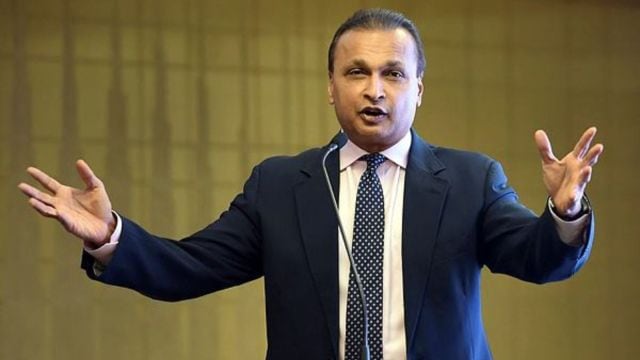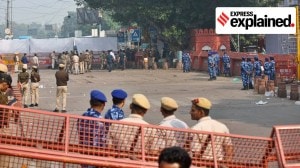
By 2017–2018, many of these firms had either entered bankruptcy or faced severe distress. Reliance Communications – which had a market capitalisation of Rs 1.5 lakh crore at its peak in 2007 — ceased mobile operations in 2019 after filing for bankruptcy, burdened by an unmanageable debt of Rs 46,000 crore. Reliance Capital, a leading NBFC of its time, defaulted on over Rs 40,000 crore and eventually lost its insurance and asset management businesses — Nippon of Japan took over the asset management and life insurance businesses of the group, while the general insurance arm and Reliance Capital were acquired by the Hinduja-led IndusInd group through the resolution process.
Story continues below this ad
In June this year, the State Bank of India (SBI) officially labelled Reliance Communications’ loan account as “fraudulent,” alleging fund diversion that traces back to 2016.
Reliance Naval, acquired by the Reliance Group in 2015, was tasked with building five offshore patrol vessels under a Rs 2,500 crore defence deal. After years of delays and financial setbacks, the Navy cancelled the project in 2020, citing failure to meet deadlines. With over Rs 7,000 crore in debt and no restructuring plan, the company entered bankruptcy in 2020. In December 2022, Swan Energy took over its assets through the insolvency process.
As the financial empire crumbled, the group sought to restructure its remaining assets under India’s Insolvency and Bankruptcy Code. Some businesses were wound up, others dissolved or sold off, while a few found breathing room to regroup. Anil Ambani himself quit from the boards of various group companies including Reliance Infrastructure and Reliance Power. In fact, none of the family members are on the boards of major group companies. Tina Ambani is on the board of Dassault Reliance Aerospace Ltd.
In August 2024, the Securities and Exchange Board of India (SEBI) too imposed a five‑year ban on Anil Ambani and 24 other entities from participating in the securities market. He was also hit with a Rs 25 crore penalty (approximately $3 million) for orchestrating a fraudulent scheme to siphon off funds from Reliance Home Finance Ltd (RHFL) via unsafe general‑purpose working capital loans to entities linked to the promoters.
Story continues below this ad
Last month on June 13, State Bank of India classified Reliance Communications along with promoter director Anil D Ambani as ‘fraud’ and on Monday the Parliament was informed that it was in the process of lodging a complaint with the CBI. The entities were classified as fraud in accordance with the RBI’s Master Directions on Fraud Risk Management and Bank’s Board-approved Policy on Classification, Reporting & Management of Frauds, Minister of State for Finance Pankaj Chaudhary said in a written reply in the Lok Sabha
Infra, power revival plans
From 2022 onward, the Anil Ambani group began a cautious, if ambitious, attempt at revival– pivoting towards clean energy, infrastructure, and defence manufacturing. This new strategy placed sustainability and technology at its core, with a renewed focus on solar power and battery energy storage. The group’s revival plan is led by power and infrastructure arms.
Reliance Power has an operating portfolio of 5,305 MW, that includes 3960 MW Sasan Power Limited (world’s largest integrated coal-based power plant). Following Reliance Power’s achievement of zero debt, Rosa Power, which operates a 1,200 MW coal-based thermal power plant in UP, is now on track to become debt-free. The company aims to settle its remaining debt in the next quarter, completing the process before the end of the current financial year.
It’s now planning to invest over Rs 10,000 crore in a solar power plant and an integrated solar manufacturing facility in Andhra Pradesh. Reliance Power made a profit of Rs 2,947 crore in FY24 and Rs 44.79 crore in the June quarter of FY26.
Story continues below this ad
Reliance Infrastructure, once weighed down by debt, reported zero standalone net debt by FY 2025 and posted a net profit of Rs 216 crore in Q4 of FY25 as against a loss of Rs 3,202 crore in Q3 of FY25. India Ratings recently upgraded Reliance Infra’s rating from D to B, pointing to the timely servicing of standalone debt obligations for three consecutive months ended 30 June 2025.
However, it said Reliance Infra continues to face elevated group-level risk due to the financial distress in several subsidiaries. The company now operates through a diversified network of special purpose vehicles (SPVs) across critical growth sectors such as power, roads, metro rail, airports, and defence.
During FY25 and 1QFY26, Reliance Infra made significant progress in resolving legacy financial obligations arising from corporate guarantees and other liabilities.
Reliance Power stocks saw a 121 per cent rally from the 52-week low, signalling renewed investor interest. However, promoter holding in Reliance Infra remains modest at just 19.05 per cent, reflecting continued capital dilution and financial restructuring. Reliance Infra and Reliance Power — the two major listed entities — have a market capitalisation of Rs 14,262 crore and Rs 24,690 crore respectively now.
Story continues below this ad
At its peak in 2008 before various companies collapsed, the group had a market capitalisation of Rs 3.45 lakh crore.
Reacting to the ED raids, Reliance Infra and Reliance Power said in similarly-worded statements that the ED’s actions “have absolutely no impact on the business operations, financial performance, shareholders, employees, or any other stakeholders”, and that the companies have no business or financial linkage to Reliance Communications and Reliance Home Finance, which are purportedly at the centre of the ED’s action.
Aerospace and defence: Big plans but miles to go
In the aerospace sector, the group had earlier formed Dassault Reliance Aerospace Ltd (DRAL) in 2017, a joint venture with France’s Dassault Aviation under the offset obligations of the Rafale fighter jet deal. While DRAL did deliver aerostructure components—such as cockpit assemblies—for Falcon 2000 jets, its role remained modest, accounting for only a small part of the total offset value. Plans are now afoot to deepen the partnership between Dassault and the Reliance Group, with plans to manufacture the former’s business jets in India.
Dassault and Reliance Group announced last month that DRAL will be setting up a final assembly line (FAL) for manufacturing the Falcon 2000 jets at Nagpur. The first made-in-India Falcon 2000 jet is expected to be ready by 2028. This will be the first instance of Dassault manufacturing the popular business jet outside France. The made-in-India jets will cater to rising business jet demand in India and international markets, according to the partners.
Story continues below this ad
At Mihan, Nagpur, DRAL has a manufacturing facility for making various sections of Dassault’s best-selling business executive jet–the Falcon 2000. Since delivering its first Falcon 2000 front section in 2019, DRAL has assembled over 100 major sub-sections for the Falcon 2000. While Dassault and the Reliance Group have not spelt out the capacity of the Falcon 2000 production facility at Nagpur, but sources in the know indicated that it could be up to 24 aircraft a year. This would be the first-ever instance of a foreign aircraft manufacturer setting up an FAL in India for fixed-wing civilian aircraft.
Over time, however, Dassault’s newer defence partnerships have increasingly leaned toward other Indian players like Tata, signalling a reduced reliance on the Anil Ambani group in this space.
The group recently announced big plans in the ammunition segment also. In June 2025, Reliance Defence formed a strategic partnership with Diehl Defence of Germany to manufacture Vulcano 155 mm precision-guided artillery shells domestically. In May 2025, the group signed an agreement with Rheinmetall AG, another major German defence manufacturer to supply explosives and propellants for medium and large-calibre ammunition.
Despite years of financial turbulence, the group has shown signs of resilience and reinvention. Though much of the original empire lies dismantled, a leaner, more focused Anil Ambani Group is trying to chart a comeback—anchored in energy, infrastructure, and defence, yet still shadowed by its legacy of debt and regulatory scrutiny.

































